Temple hair loss: How to fight back
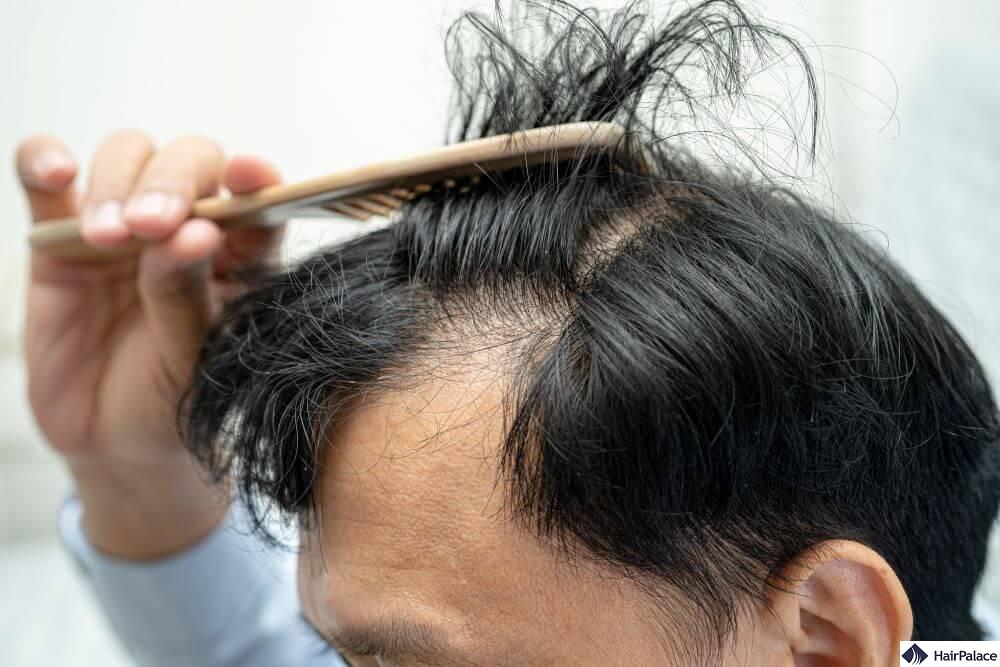
Temple hair loss can affect both men and women and impact confidence, whether due to genetics, stress, tight hairstyles, or hormonal shifts.
Noticing thinning or recession around your temples can be unsettling, it’s often one of the first visible signs of hair loss.
The good news is that with the right approach, you can slow it down, stimulate regrowth, and protect the hair you still have.
In this article, we’ll explore the causes of temple hair loss and share effective, science-backed strategies to help you fight back, naturally and confidently.
- What is temple hair?
- What causes temple hair loss
- Treatment options
- How to regrow temple hair naturally
- Can you prevent hair loss at the temples?
What is temple hair?

Temple hair is the hair that grows on the sides of your head, just above and slightly in front of your ears.
The temples themselves are the flat, gently curved areas on both sides of your forehead, where the hairline naturally curves back toward the ears.
This region is a key part of the hairline and plays an important role in framing your face.
Hair loss at the temples is often one of the first visible signs of male pattern baldness (androgenetic alopecia), though women can experience thinning in this area as well.
Because of its prominent position, even minor hair loss at the temples can make the hairline look uneven or give the face a more aged appearance.
This area is also particularly sensitive to hormonal changes and DHT (dihydrotestosterone) a major contributing factor in pattern hair loss.
That’s why it’s one of the first spots where thinning becomes noticeable.
What causes temple hair loss
Temple hair loss can be caused by multiple conditions, here’s a look at some of the most common.
1. Androgenetic Alopecia Male or Female Pattern Baldness
This is the most common cause of temple hair loss and is largely genetic.
In male pattern hair loss, it often begins with a receding hairline at the temples, forming an “M” shape.
When it comes to female pattern hair loss, the hair tends to thin more diffusely, but temple thinning can still occur.
Balding is driven by sensitivity to DHT (dihydrotestosterone), which shrinks hair follicles over time.
2. Stress and Telogen Effluvium
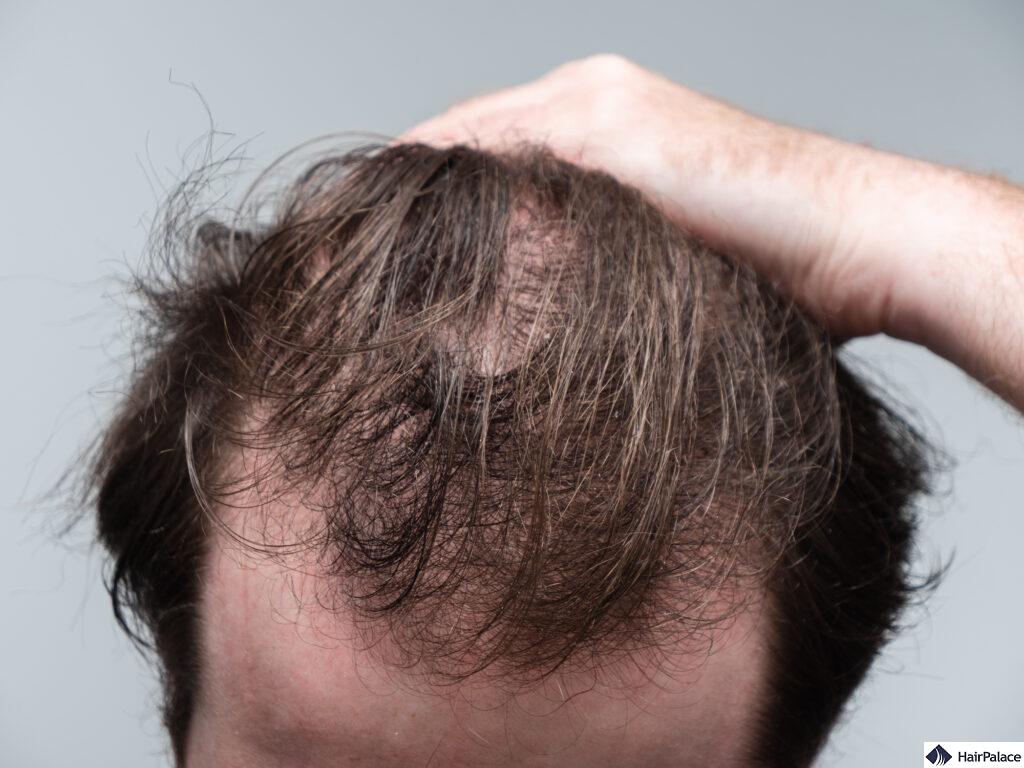
Physical or emotional stress can trigger a shift in the hair growth cycle, causing many hair follicles to enter the resting (telogen) phase prematurely, which often results in increased hair shedding.
This condition, called telogen effluvium, may cause thinning around the temples or other areas.
It’s typically temporary, but the hair loss can feel sudden and alarming.
Once the underlying stress is resolved, hair usually regrows within a few months.
3. Tight Hairstyles (Traction Alopecia)
Hairstyles that place constant tension on the hairline, such as tight ponytails, braids, or buns, can lead to a form of hair loss called traction alopecia.
The temples are particularly vulnerable because they’re often under constant tension.
Over time, this stress damages hair follicles and can lead to permanent loss if not addressed.
Switching to looser hairstyles can help prevent further damage.
4. Hormonal Changes
Fluctuations in hormones, such as those during pregnancy, menopause, or thyroid imbalances, can lead to hair thinning, especially around the temples.
Estrogen helps maintain hair growth, so a drop in levels may trigger shedding.
Conditions like polycystic ovary syndrome (PCOS) can also lead to hormone-related temple hair loss.
Treating the underlying imbalance often improves hair health.
5. Nutritional Deficiencies

Lack of essential nutrients like iron, zinc, biotin, or protein can affect hair growth and strength.
The hair at the temples may appear thinner or more fragile if the body isn’t getting what it needs.
Crash diets or restrictive eating habits are common culprits.
Blood tests can help identify deficiencies, and supplementation or dietary changes may restore balance.
6. Autoimmune Conditions (e.g., Alopecia Areata)
In some cases, the body’s immune system mistakenly attacks healthy hair follicles, leading to sudden and patchy hair loss. Alopecia areata can cause bald spots, including at the temples.
The condition can be unpredictable—hair may grow back spontaneously or fall out again.
Medical treatment, such as corticosteroids, can manage flare-ups.
Temple hair loss treatment options
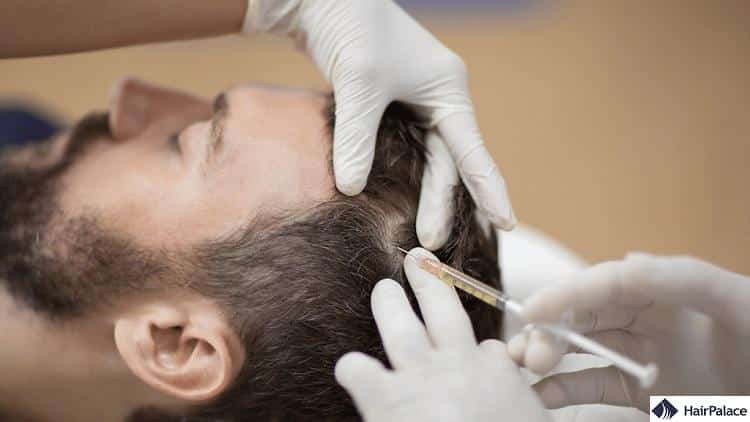
1. Minoxidil
Minoxidil is a widely used, FDA-approved topical treatment for hair loss. It’s available in 2% and 5% solutions or foam and works by increasing blood flow to the hair follicles.
This improved circulation helps extend the anagen (growth) phase of the hair cycle and may enlarge miniaturized follicles, making hair appear thicker and healthier over time.
Visible results typically appear after 3 to 6 months of consistent use.
2. Finasteride
Finasteride is a prescription pill that treats male pattern baldness by inhibiting the 5-alpha reductase enzyme, which converts testosterone into DHT (dihydrotestosterone).
DHT is the hormone responsible for miniaturizing hair follicles in genetically susceptible individuals—especially around the temples and crown.
Because the temples are highly sensitive to DHT, finasteride can help prevent further loss in this area and may promote regrowth if follicles are still active.
However, both minoxidil and finasteride must be used on an ongoing basis to maintain hair growth.
3. Low-Level Laser Therapy (LLLT)
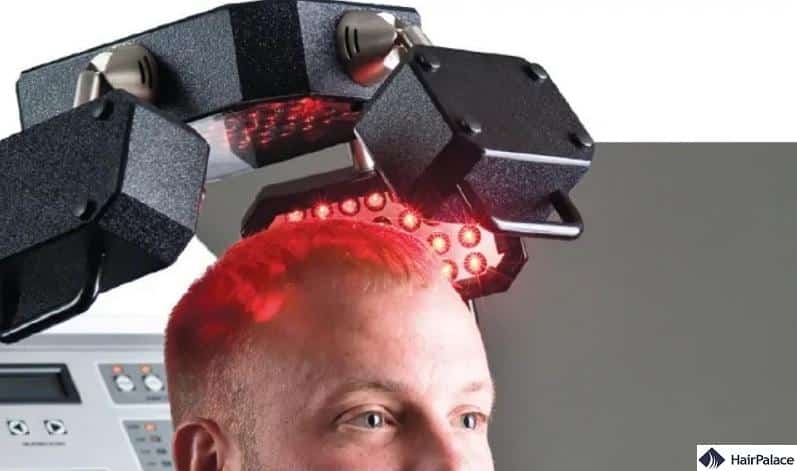
LLLT uses safe, low-intensity red or near-infrared light to stimulate cellular activity in the scalp.
This enhances ATP production, boosts blood flow, and promotes healthier follicle function.
Devices like laser combs, helmets, or caps can be used at home regularly, usually 3–5 times per week.
LLLT can be used to target thinning at the temples and other areas, especially when hair follicles are still present but weakened.
Improvements often take 12–16 weeks or longer. It’s a gradual process, and consistency is key.
4. Platelet-Rich Plasma (PRP) Therapy
PRP treatment begins by drawing a small sample of the patient’s blood, which is then placed in a centrifuge to separate and concentrate the platelets.
This platelet-rich plasma is subsequently injected into the scalp to stimulate hair growth and support follicle health.
Platelets contain growth factors that help repair and stimulate hair follicles.
PRP can be especially useful for early-stage hair loss in the temples, where follicles may be weakened but not dead.
It’s often used in combination with other treatments like minoxidil or finasteride for enhanced results.
5. Temple hair transplant
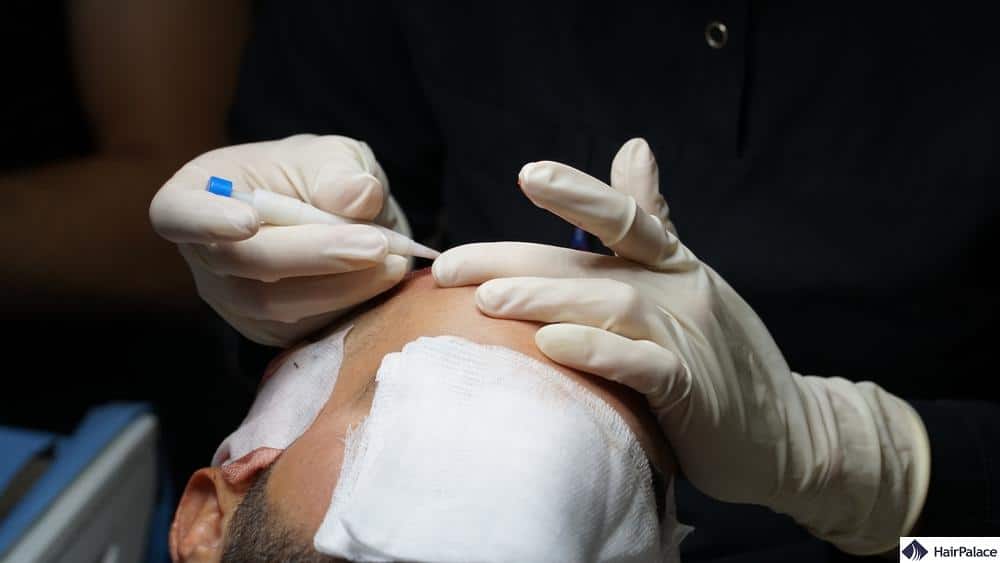
A surgical option for more advanced temple hair loss, hair restoration surgery involves relocating healthy hair follicles from a donor area to thinning or bald regions.
There are two main types: FUT (strip method) and FUE.
Transplants can effectively rebuild receding temple hairlines and are especially popular among men looking to treat temple hair loss.
Temple hair transplant cost
The cost of a temple hair transplant depends on several factors, including the extent of hair loss, the number of grafts required, and the clinic’s location.
In the United Kingdom, prices typically range from £3,000 to £7,000, with an average cost of around £4,820 for approximately 1,500 grafts.
Internationally, countries like Hungary offer more affordable, all-inclusive packages—allowing you to save up to 70% without compromising on quality.
6. Hormonal Therapy (Primarily for Women)
Hormonal imbalances such as those from menopause, PCOS, or thyroid disorders can lead to temple hair thinning in women.
Treatments may include oral contraceptives, spironolactone, or hormone replacement therapy, depending on the cause.
Correcting the hormonal imbalance can stabilize shedding and support regrowth in the temple area. It’s often paired with other treatments like minoxidil.
7. Nutritional Supplements

Hair needs adequate nutrients to grow strong and healthy.
Deficiencies in iron, vitamin D, biotin, zinc, omega-3s, and protein can all contribute to temple hair thinning.
Supplements help restore these essential nutrients and support follicle function.
Supplementation can help if the hair loss is tied to poor nutrition or rapid weight loss. A blood test is helpful to identify specific deficiencies.
8. Scalp Micropigmentation (SMP)
SMP is a non-surgical cosmetic procedure that uses tiny dots of pigment tattooed on the scalp to create the illusion of fuller hair or restore the look of a defined hairline.
It doesn’t stimulate hair growth, but it can disguise thinning, especially at the temples.
Ideal for those with advanced loss or who aren’t candidates for transplants.
It’s often chosen by people who shave their heads or keep their hair very short.
How to regrow temple hair naturally
1. Scalp Massage
Scalp massage is a simple yet powerful way to encourage natural hair regrowth, especially around sensitive areas like the temples.
By massaging the scalp regularly (ideally for 5 to 10 minutes a day) you help increase blood circulation, which delivers oxygen and nutrients to hair follicles.
This stimulation can help extend the hair’s growth phase and awaken dormant follicles.
Consistency is key, and over time, daily scalp massage can promote hair growth in the temple region.
2. Natural Oils
Certain natural oils are especially effective in supporting hair health and addressing thinning hair, particularly around the temples.
Rosemary oil is well-regarded for its ability to improve blood circulation and stimulate hair follicles, encouraging growth.
Rosehip oil, rich in antioxidants and essential fatty acids, nourishes the scalp and helps maintain healthy skin around the hairline.
Olive oil deeply moisturizes and strengthens the hair, while marula oil provides lightweight hydration and protects against environmental damage.
To use, gently massage a small amount of your chosen oil into the temples and leave it on for at least 30 minutes, or overnight, before rinsing.
3. Aloe Vera
Aloe vera offers soothing, anti-inflammatory benefits that make it a great natural ally against female temple hair loss.
Applying fresh aloe gel to the temple area can calm any irritation or inflammation that might be impeding healthy hair growth.
It also helps clear away excess oil, dead skin cells, and buildup that can clog follicles.
Aloe is rich in enzymes and minerals that nourish the scalp and create an ideal environment for hair to thrive.
Use it two to three times per week by applying a small amount of gel directly to the temples, leaving it on for 30–60 minutes, and then rinsing it out with water or a gentle shampoo.
4. Reduce Stress
Stress is a major factor in hair loss, particularly in areas like the temples where hair follicles may already be more sensitive.
High-stress levels can lead to a condition called telogen effluvium, in which hair prematurely enters the resting phase and falls out in clumps.
Chronic stress can also disrupt hormone levels and contribute to inflammation, both of which negatively affect hair health.
Managing stress through regular physical activity, mindfulness practices, deep breathing, yoga, or even simple hobbies can make a significant difference.
5. Avoid Tight Hairstyles
Frequent tension on the hairline can cause a type of hair loss called traction alopecia, which is especially common at the temples.
Tight ponytails, braids, buns, or headbands can all place continuous stress on the hair shafts and follicles, leading to gradual thinning or even permanent damage if the habit isn’t changed.
Heat styling, chemical treatments, and rough brushing can also weaken hair over time.
To protect your temple hair, wear your hair down or in loose styles, avoid heavy styling products, and opt for gentle detangling methods.
Giving your hair a break from harsh styling allows weakened follicles the chance to recover and regrow hair naturally.
6. Herbal Remedies
In some cases, hair thinning at the temples may be related to internal imbalances or nutritional gaps, and herbal remedies or supplements can help address those.
Saw palmetto, for example, is a natural DHT blocker that may support hair regrowth in people experiencing hormone-related loss.
Pumpkin seed oil has also shown promise in reducing inflammation and supporting scalp health.
Can you prevent hair loss at the temples?

In many cases, hair loss at the temples can be prevented or at least slowed down, especially when addressed early.
The key lies in understanding the root cause, whether it’s genetic, hormonal, lifestyle-related, or due to external factors, and taking proactive steps to support scalp and follicle health.
If genetics are a factor, early intervention with treatments like minoxidil, DHT blockers, or low-level laser therapy can help preserve hair density in the temple area.
While you can’t change your genes, you can influence how they are expressed through consistent care and scalp stimulation.
Preventing traction alopecia a common cause of temple thinning is also very achievable.
This form of hair loss results from constant tension on the hairline from certain hairstyles.
By wearing your hair in looser styles and avoiding daily pulling or chemical processing, you give the follicles a chance to stay healthy and anchored.
Nutritional support plays a huge role, too.
A diet rich in protein, iron, zinc, biotin, and healthy fats feeds the follicles from within and supports strong, resilient strands.
If you’re deficient in key nutrients, correcting that early can make a real difference in slowing or preventing hair loss.
- Ho, C., & Hughes, J. (2017, March 6). Alopecia, Androgenetichttps://www.ncbi.nlm.nih.gov/books/NBK430924/
- Manabe M, Tsuboi R, Itami S, Osada SI, Amoh Y, Ito T, Inui S, Ueki R, Ohyama M, Kurata S, Kono T, Saito N, Sato A, Shimomura Y, Nakamura M, Narusawa H, Yamazaki M., Drafting Committee for the Guidelines for the Diagnosis and Treatment of Male- and Female-Pattern Hair Loss. Guidelines for the diagnosis and treatment of male-pattern and female-pattern hair loss, 2017 version. J Dermatol. 2018 Sep;45(9):1031-1043.https://pubmed.ncbi.nlm.nih.gov/29863806
- Williamson, D., Gonzalez, M. and Finlay, A. (2001), The effect of hair loss on quality of life. Journal of the European Academy of Dermatology and Venereology, 15: 137-139.https://doi.org/10.1046/j.1468-3083.2001.00229.x
- Ross EK, Shapiro J. Management of Hair Loss. Dermatologic Clinics 2005;23(2):227-243.https://doi.org/10.1016/j.det.2004.09.008.
- Gordon KA, Tosti A. Alopecia: evaluation and treatment. Clinical, cosmetic and investigational dermatology. 2011 Jul 19:101-6.https://doi.org/10.2147/CCID.S10182


